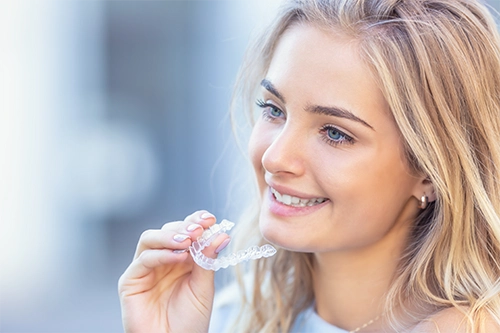
Patient Info
Dental Implants
Cosmetic Dentistry
General Dentistry

The two most common orthodontic treatments for malocclusion, or misaligned teeth, are Invisalign clear aligners and metal braces. They are used to improve the aesthetics and feel of your smile. Both methods put pressure on the teeth to align them properly in the jaw and correct what dental professionals refer to as “bad bite.”
Traditional metal braces are made of brackets attached to a wire, fitted to your teeth. On the other hand, clear aligners- such as Invisalign- were created in the late 1990s to address some of the issues that often come with traditional metal braces.
In this article, we’ll discuss the differences between Invisalign clear aligners and metal braces including price, aesthetics, comfort, effectiveness, care and cleaning, and more.
Invisalign clear aligners and metal braces are both used to correct issues with alignment and spacing of your teeth. Let’s take a closer look at both of these orthodontic treatments when it comes to price, comfort, speed, aesthetics of your smile, effectiveness, care/cleaning, and more.
There are several factors that go into determining the cost of orthodontic treatments.
Traditionally, in the USA, metal braces cost about $3,000 to $7,000. Invisalign clear aligners are about the same, maybe a bit higher. The costs vary based on the complexity of your dental situation, how long your treatment lasts, where you are located, and the orthodontist you choose to work with.
Some dental plans cover a portion of these treatments for kids and teens. However, it’s important to understand that metal braces may be covered more than Invisalign. You may also want to ask your dentist about financing options or in-house payment plans to make the treatment more affordable.
According to the experts, patients with traditional metal braces experience more pain and discomfort than those with Invisalign- especially when treatment first begins and every time the orthodontist must tighten them.
Many patients report that they had to get used to wearing the clear aligners and it’s important to note that you may experience increased salivation and have a lisp in the first few days after starting treatment.
Patients with metal braces may also experience discomfort when the metal scrapes or pushes against the inside of their mouth. Since Invisalign clear aligners are made from transparent, smooth plastic, you don’t have to worry about this.
The U.S. Food and Drug Administration, or FDA, has approved both traditional metal braces and Invisalign clear aligners for treating malocclusion.
Traditional metal braces are typically the treatment of choice for patients with complex dental issues, such as severe crowding, rotated teeth, or large gaps. On the other hand, Invisalign clear aligners are used to treat mild to moderate malocclusion.
Traditional metal braces typically take 1 to 2 years to work. However, patients who choose Invisalign usually only have to wear them for 12 to 18 months. In fact, some people only need them for 6 months- but there are some that need them longer than 18 months. The speed of treatment depends on several personal factors. Therefore, you’ll want to discuss your situation with your orthodontist about what you should expect.
Traditional metal braces are made of small brackets affixed to your teeth. A wire is attached to those and then fitted with bands. There are several options for the brackets: metal, plaster, ceramic, or other materials. You may choose from a variety of different colors for your brackets.
Another “traditional” metal braces option is lingual braces. These are attached to the back of your teeth, so they are not seen as well.
Many adult patients choose Invisalign because it isn’t seen as easily. The plastic aligners look like clear retainers and are made to fit your mouth. Even from a short distance away, they are barely visible.
In order to avoid tooth decay- and further dental treatment such as dental implants- you need to at least brush your teeth after every meal/snack and floss at least once daily- especially if you wear braces. Ideally, you’ll want to use an interdental brush, which has a tiny brush that goes between your teeth.
Experts state that patients who use Invisalign have fewer calories, less tooth decay, and have fewer gum issues than those with metal braces. In order to avoid the buildup of bacteria and calcium, you’ll also want to wash your aligner after every meal.
When you have metal braces, you’ll be given a list of foods that you can’t eat, such as chewy candy/gum, pears, nuts, popcorn, apples, carrots, and more. One of the primary advantages of clear aligner is that they can be removed for eating, drinking, or brushing.
It’s a good idea to remove your aligner and eat/drink, just make sure that you put it back in and then brush/floss your teeth and wash the aligner before putting back in.
The first step to getting traditional metal braces is a thorough exam and x-rays. The orthodontist will then attach the brackets to your teeth with an adhesive and thread a wire through them. the wire and brackets will be held in place with a series of rubber bands.
Over the course of your treatment, you’ll visit the orthodontist several times to have your braces tightened. Once the braces are removed, you may be required to wear a retainer for 1 to 3 years to maintain results.
The first step for Invisalign is the same: exam and x-rays. After that, the dentist will make a mold of your teeth and send it to the lab to have a series of customized aligner trays made. The first set of aligners may be secured to your teeth with attachments. Every 2 to 3 weeks, you’ll switch to a new set of aligners.
For best results- and the shortest treatment time- you’ll need to wear your aligners for at least 22 hours per day. If you’re forgetting to put them back in after you eat, drink, or brush/floss your teeth, they’re not going to be effective.
Both traditional metal braces and Invisalign are made to treat malocclusion- which means they can straighten your teeth, improve your smile, and correct common dental issues (overbite/underbite/crossbite/etc). Patients who are self-conscious- especially adults- typically prefer something discreet, such as Invisalign clear aligners.
That being said, Invisalign isn’t ideal for everyone. If you’ve already been through other orthodontic treatments, it may not work for you. If you have any of the following issues, clear aligners may not be the best option for you:
Traditional metal braces are typically more effective for the more severe cases.
Both braces and Invisalign clear aligners are used for malocclusion, which is also referred to as “bad bite”. Both options can help with your smile.
Many people choose Invisalign instead of traditional braces because they are more discreet. Also, Invisalign is usually more comfortable, and you don’t have to visit the orthodontist as much. Since you can remove the aligners, you don’t have as many restrictions for what you can eat and drink. However, you must remember to put them back in and wear them for at least 22 hours a day for best results.
That being said, for patients who have more complex dental issues, traditional metal braces may be a better option. Costs are similar- but traditional metal braces are more likely to be covered than Invisalign.
Ultimately, you have to weigh the pros and cons of each to decide which one is best for you.
My visit was incredible. I had my “All on Four” appliances cleaned, and it was a painless and thorough experience. Dr. Scott and all his staff are very friendly. During the cleaning, Mary was gentle and let me know everything she was doing and how it would feel. She gave me tips on how to clean my implants/appliances better and gave me a small brush to do the underside more effectively. Dr. Scott and Mary suggest cleanings take place every 3 months so I will be back in December.

Dr. Byron Scott is a highly-trained and accomplished dentist. He attended The University of Alabama School of Dentistry and subsequently completed numerous Advanced Studies and Trainings. Dr. Scott is Board-Certified by The Academy of General Dentistry and has earned Mastership status (MAGD), an honor shared by only 1% of dentists. He has numerous memberships and associations, including Diplomate status with The American Board of Oral Implantology (D-ABOI) and The International Congress of Oral Implantologists (D-ICOI). Overall, Dr. Scott has dedicated his life and career to helping patients improve their oral health through expert dentistry. His goal is to help each patient keep their smile healthy, attractive, and comfortable for the duration of their lifetime.
